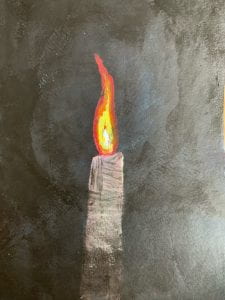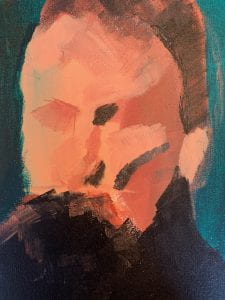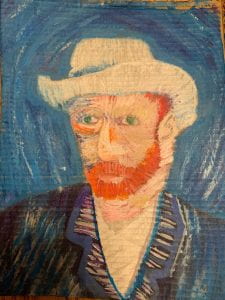This week’s skill we had to practice from How To Have A Beautiful Mind was a thinking method. Specifically, the six hats think method. It involves thinking in six separate ways to help you move towards a goal. It’s called six hats because the creator thought the image of a hat would be a good way to help people move between the different ways of thinking. The creator also assigned the different thinking styles colours based on what they are and how you use them. For example, the hat for proven facts and information is the white hat and the red hat is used for sharing emotions and what your intuition says. In total there are six different colours, white, red, black, yellow, green, and blue. All of them serve a different purpose.
I only had one meeting with my mentor, but it was just under twenty minutes, so I had plenty of time to practice the skills for multiple hats. After we had gotten the introductions out of the way, I said “I sent you a picture of the candle painting I did, but I find it looks flat. It feels dull when you look at it and that’s not what I wanted. Do you know how to make it, so it looks like your painting glows?” He told me about contrasting the lights by a nearby dark. His exact words were “To make flames glow you must paint them adjacent to very dark colours.” I said, “I feel like that would work.”.
If you can’t tell, I was trying to practice the red hat here. Under the red hat you are supposed to express emotions. In the book it said an important part of the red hat is that you don’t give reasons for your feelings. That is why I said, “I feel like that would work.”, instead of saying, “I feel like that could work because…”. Later In the meeting we were back on the topic of painting hair (if you don’t understand look back at my last post). My mentor said, “Hair is really not that difficult, you don’t need to worry about it.” I said, “My intuition tells me I will find it difficult.” My mentor then said, “If you are so worried, we can continue practicing hair.” Using the red hat and expressing my emotions really helped my mentor see my perspective, when he otherwise wouldn’t have.
A time I used the white hat during my meeting was when we were talking about painting eyes. I said, “What do I need to know to paint better eyes?”. My mentor said, “You just need to remember to keep the bottom eye lid straight and curve the top one. You also want to make sure you make the eyes point the same direction, which just requires you to take a step back and look at your painting.”. After he said that I thought to myself “What information is missing? How can I find more information on painting eyes?” I decided afterward I would do some research and watch some YouTube videos about painting eyes to help me find any information I am missing.
After this I also used the yellow hat to think of the value in what he said, instead of just going to a YouTube video. I thought “He proved to me how much of a difference the small changes to the shape of the eye make. Then making them point the same direction is obvious. Maybe painting eyes is really just that simple.”
The final hat I used was the black hat. The black hat is critical thinking. I found it a bit tricky to use because my mentor is a very logical person. I used it while we were talking about my Van Gogh painting (see below). My mentor had recommended I use cardboard as a painting surface. I pointed out that cardboard would bend and warp when I put acrylic paint on it. He agreed but made the point that going out to get the properly sized canvas is annoying and timely. It would far more efficient to use a spare piece of cardboard. I agreed and painted it on cardboard.
I didn’t really get to use the green hat or the blue hat because they are more used during collaboration and meetings. Especially the blue hat, which is used to direct the meeting and the use of the other hats.
This week I only did three paintings. Two of which my mentor assigned me and one that I just wanted to try. I did so few because I have started taking multiple days to work on a single piece. This allows me time to work through the details and get the painting the way I want it, as well as time to go back to correct mistakes.
The first assignment my mentor gave me was to paint a classic Van Gogh. It was a portrait he did of himself in a grey hat. As you may know, Van Gogh’s more famous works are pointillism (dots and dashes). This painting is no different. But my mentor didn’t give me this assignment because of the pointillism. He gave it to me because he wanted me to practice using complementary colours and estimating sizes of portraits.
I did this painting on a 7 x 9 piece of cardboard (half the size of the original). I did a good job getting the general proportions of the face, and considering it was my first-time doing pointillism, I did that well. One thing that frustrated me while I was painting this was my brushes. The lines and dots I painted needed to be small and controlled. My brushes however didn’t really want me to do this. I used one of the smallest brushes I have, and I still couldn’t get the lines the way I wanted them because the ends of my brushes had gotten slightly frayed.
The next painting, I did was of a small candle. This painting was very simple. It was a background, a flame, and a candle. I did this painting because I wanted to practice making things glow. Unfortunately, this painting doesn’t really glow the way I had hoped. I asked my mentor how to make things glow and he said that you need to have bright colours contrasted by dark colours nearby. With this info, I went back the next day and darkened the background. It didn’t work. It still doesn’t glow. I will need to continue to practice.
The final painting, I did this week was one my mentor assigned me. It was a painting of a famous sculptor named Rodin. My mentor gave it to me because two weeks ago I requested to practice painting hair. To do this while still working on portraits my mentor gave me this painting. Rodin had a beard which would be a great way to practice facial hair. The only problem is I am still working on it. Though this shows some of the steps I go through when painting a portrait.



